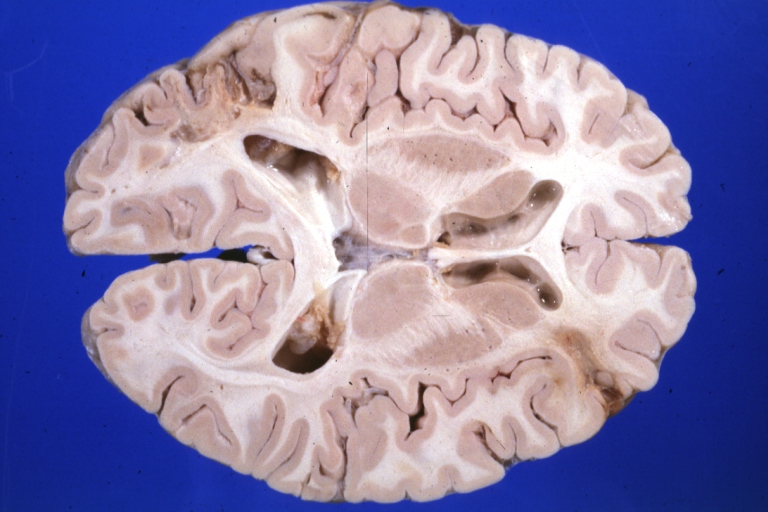Encephalopathy
| Encephalopathy | |
 | |
|---|---|
| Binswangers Subcortical Encephalopathy: Gross fixed tissue horizontal section cerebral hemispheres at level of genu internal capsule Image courtesy of Professor Peter Anderson DVM PhD and published with permission © PEIR, University of Alabama at Birmingham, Department of Pathology | |
| MeSH | D001927 |
|
WikiDoc Resources for Encephalopathy |
|
Articles |
|---|
|
Most recent articles on Encephalopathy Most cited articles on Encephalopathy |
|
Media |
|
Powerpoint slides on Encephalopathy |
|
Evidence Based Medicine |
|
Clinical Trials |
|
Ongoing Trials on Encephalopathy at Clinical Trials.gov Trial results on Encephalopathy Clinical Trials on Encephalopathy at Google
|
|
Guidelines / Policies / Govt |
|
US National Guidelines Clearinghouse on Encephalopathy NICE Guidance on Encephalopathy
|
|
Books |
|
News |
|
Commentary |
|
Definitions |
|
Patient Resources / Community |
|
Patient resources on Encephalopathy Discussion groups on Encephalopathy Patient Handouts on Encephalopathy Directions to Hospitals Treating Encephalopathy Risk calculators and risk factors for Encephalopathy
|
|
Healthcare Provider Resources |
|
Causes & Risk Factors for Encephalopathy |
|
Continuing Medical Education (CME) |
|
International |
|
|
|
Business |
|
Experimental / Informatics |
Editor-In-Chief: C. Michael Gibson, M.S., M.D. [1]
Please Take Over This Page and Apply to be Editor-In-Chief for this topic: There can be one or more than one Editor-In-Chief. You may also apply to be an Associate Editor-In-Chief of one of the subtopics below. Please mail us [2] to indicate your interest in serving either as an Editor-In-Chief of the entire topic or as an Associate Editor-In-Chief for a subtopic. Please be sure to attach your CV and or biographical sketch.
Overview
Encephalopathy literally means disease of the brain. It is a brain malfunction in the face of systemic metabolic derangements due to cardiopulmonary, mitochondrial, renal, hepatic or endocrine disease. In medical jargon it can refer to a wide variety of degenerative brain disorders with very different etiologies, prognoses and implications. For example, prion diseases, all of which cause transmissible spongiform encephalopathies, are nearly always fatal and have an infectious origin, but other encephalopathies are reversible and can be caused by deficiency, toxins, and several other causes.
Types
There are many types of encephalopathy. Some examples include:
- Mitochondrial encephalopathy - Metabolic disorder caused by dysfunction of mitochondrial DNA. Can affect many body systems, particularly the brain and nervous system.
- Glycine encephalopathy - A pediatric metabolic disorder
- Hepatic encephalopathy - Arising from advanced cirrhosis of the liver
- Hypoxic encephalopathy - Permanent or transitory encephalopathy arising from severely reduced oxygen delivery to the brain
- Static encephalopathy - Unchanging, or permanent, brain damage
- Uremic encephalopathy - Arising from high levels of toxins normally cleared by the kidneys -- rare where dialysis is readily available
- Wernicke's encephalopathy - Arising from thiamine deficiency, usually in the setting of alcoholism
- Hashimoto's encephalopathy - Arising from an auto-immune disorder
- Hypertensive encephalopathy - Arising from acutely increased blood pressure
- Toxic-Metabolic encephalopathy - A catch-all for brain dysfunction caused by infection, organ failure, or intoxication.
- Transmissible spongiform encephalopathy - A collection of diseases all caused by prions, and characterized by "spongy" brain tissue (riddled with holes), impaired locomotion or coordination, and a high fatality rate. Includes bovine spongiform encephalopathy (mad cow disease), scrapie, and kuru among others.
Causes
Encephalopathy alters brain function and/or structure. It may be caused by an infectious agent (bacteria, virus, or prion), metabolic or mitochondrial dysfunction, brain tumor or increased intracranial pressure, prolonged exposure to toxins (including solvents, drugs, alcohol, paints, industrial chemicals, and certain metals), radiation, chronic progressive trauma, poor nutrition, or lack of oxygen or blood flow to the brain. It is also known that concomitant use of lithium with other neuroleptics may, in rare cases, cause encephalopathy.
The hallmark of encephalopathy is an altered mental state. Depending on the type and severity of encephalopathy, common neurological symptoms are progressive loss of memory and cognitive ability, subtle personality changes, inability to concentrate, lethargy, and progressive loss of consciousness. Other neurological symptoms may include myoclonus (involuntary twitching of a muscle or group of muscles), nystagmus (rapid, involuntary eye movement), tremor, muscle atrophy and weakness, dementia, seizures, and loss of ability to swallow or speak.
Diagnosis
Blood tests, spinal fluid examination by lumbar puncture, imaging studies, electroencephalography.
Therapy
Treatment is symptomatic and varies, according to the type and severity of the encephalopathy. Anticonvulsants may be prescribed to reduce or halt any seizures. Changes to diet and nutritional supplements may help some patients. In severe cases, dialysis or organ replacement surgery may be needed.
Prognosis
Treating the underlying cause of the disorder may improve or reverse symptoms. However, in some cases, the encephalopathy may cause permanent structural changes and irreversible damage to the brain. Some encephalopathies can be fatal.
References
The Diagnosis of Stupor and Coma by Plum and Posner ISBN 0195138988 remains one the of best detailed observational references to the condition
See also
Template:CNS diseases of the nervous system Template:SIB
de:Enzephalopathie id:Ensefalopati it:Encefalopatia nl:Encefalopathie